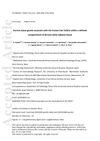TLDR The method helps study hair follicle stem cells and calcium signals in mouse skin.
The study outlined protocols for wholemount staining and intravital calcium imaging of mouse tail skin, using genetically modified mice to express calcium indicators in hair follicle stem cells (HFSCs). It demonstrated the use of two-photon microscopy to observe calcium signaling in HFSCs, particularly during the catagen-telogen phases of hair follicles. Calcium flashes were observed in plucked hair follicles during the telogen phase, unlike in control follicles. The research addressed challenges such as imaging depth limitations and potential mouse mortality, offering solutions like adjusting anesthesia levels. The study emphasized the importance of experimental consistency and provided detailed procedural steps.
 23 citations
,
October 2021 in “Cell Stem Cell”
23 citations
,
October 2021 in “Cell Stem Cell” Hair thinning causes stem cell loss through a process involving Piezo1, calcium, and TNF-α.
 56 citations
,
June 2015 in “Nature Protocols”
56 citations
,
June 2015 in “Nature Protocols” Two-photon microscopy helps observe hair follicle stem cell behaviors in mice.
22 citations
,
April 2023 in “The Journal of Cell Biology” Calcium signaling in skin cells is crucial for communication and regeneration.
 23 citations
,
October 2021 in “Cell Stem Cell”
23 citations
,
October 2021 in “Cell Stem Cell” Hair thinning causes stem cell loss through a process involving Piezo1, calcium, and TNF-α.
97 citations
,
December 2021 in “Cells” Designing effective fluorescence microscopy experiments requires careful consideration of hardware, biological models, and imaging agents.
 18 citations
,
November 2020 in “Frontiers in Cell and Developmental Biology”
18 citations
,
November 2020 in “Frontiers in Cell and Developmental Biology” Inflammation plays a key role in activating skin stem cells for hair growth and wound healing, but more research is needed to understand how it directs cell behavior.
 36 citations
,
February 2018 in “British Journal of Dermatology”
36 citations
,
February 2018 in “British Journal of Dermatology” Sweat glands and hair follicles are structurally connected within a specific layer of skin fat.



